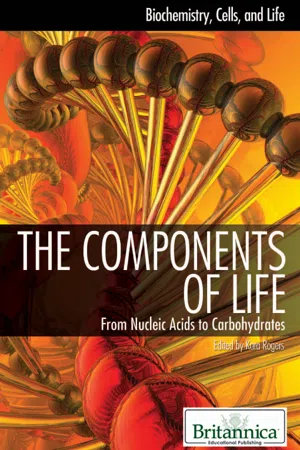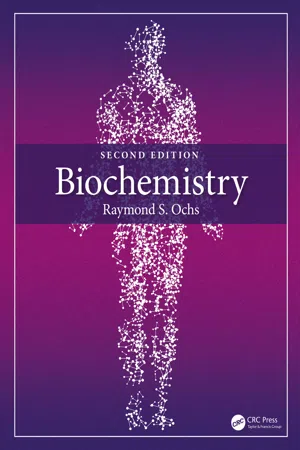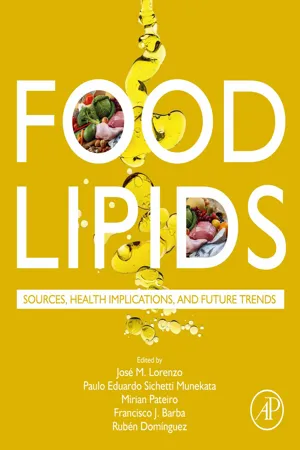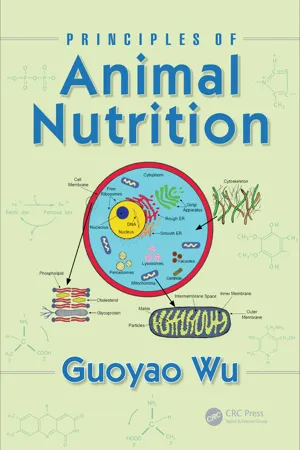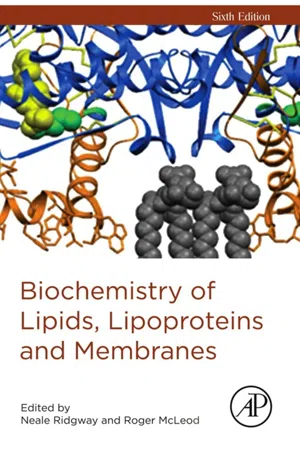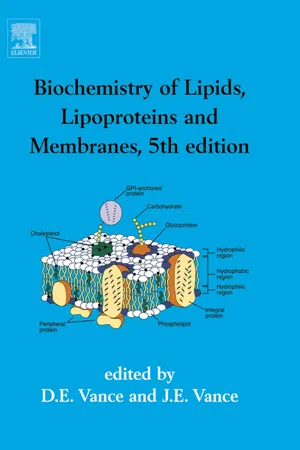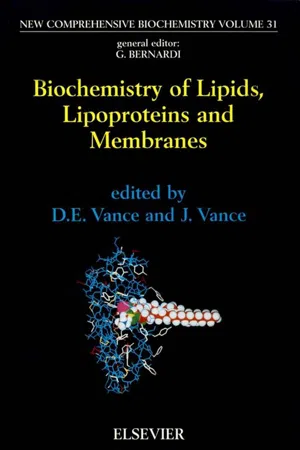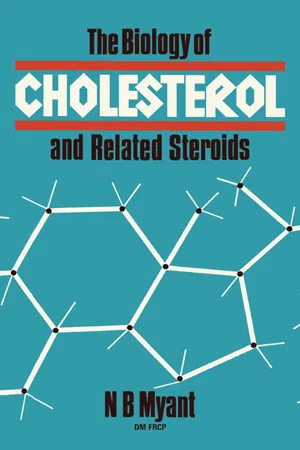Biological Sciences
Lipids
Lipids are a diverse group of organic molecules that are insoluble in water. They serve as energy storage, structural components of cell membranes, and signaling molecules. Common types of lipids include fats, phospholipids, and steroids. They play crucial roles in maintaining cell structure and function, as well as serving as a source of energy for the body.
Written by Perlego with AI-assistance
Related key terms
11 Key excerpts on "Lipids"
- eBook - ePub
Fundamentals of Biochemistry, Integrated E-Text with E-Student Companion
Life at the Molecular Level
- Donald Voet, Judith G. Voet, Charlotte W. Pratt(Authors)
- 2017(Publication Date)
- Wiley(Publisher)
lipos, fat) are the fourth major group of molecules found in all cells. Unlike nucleic acids, proteins, and polysaccharides, Lipids are not polymeric. However, they do aggregate, and it is in this state that they perform their central function as the structural matrix of biological membranes.Lipids exhibit greater structural variety than the other classes of biological molecules. To a certain extent, Lipids constitute a catchall category of substances that are similar only in that they are largely hydrophobic and only sparingly soluble in water. In general, Lipids perform three biological functions (although certain Lipids serve more than one purpose in some cells):- Lipid molecules in the form of lipid bilayers are essential components of biological membranes.
- Lipids containing hydrocarbon chains serve as energy stores.
- Many intra- and intercellular signaling events involve lipid molecules.
In this chapter we examine the structures and physical properties of the most common types of Lipids. Next, we look at the properties of the lipid bilayer and the proteins that are situated within it. Finally, we explore current models of membrane structure. The following chapter examines membrane transport phenomena. The participation of Lipids in intracellular signaling is discussed in Section 13-4 .1 Lipid Classification
KEY CONCEPTS
- The length and saturation of a fatty acid chain determine its physical properties.
- Triacylglycerols and glycerophosphoLipids contain fatty acids esterified to glycerol.
- SphingoLipids resemble glycerophosphoLipids but may include large carbohydrate groups.
- Steroids, isoprenoids, and other Lipids perform a wide variety of functions.
Lipids are substances of biological origin that are soluble in organic solvents such as chloroform and methanol. Hence, they are easily separated from other biological materials by extraction into organic solvents. They can then be separated chromatographically and identified by mass spectrometry according to their masses and characteristic fragmentation patterns (Section 5-3D - eBook - ePub
The Components of Life
From Nucleic Acids to Carbohydrates
- Britannica Educational Publishing, Kara Rogers(Authors)
- 2010(Publication Date)
- Britannica Educational Publishing(Publisher)
CHAPTER 5Hydrophobic Components: LipidL ipids are a diverse group of organic compounds that includes fats, oils, hormones, and certain components of membranes. These substances are grouped together because they do not interact appreciably with water. One type of lipid, the triglycerides, is sequestered as fat in adipose cells, which serve as the energy-storage depot for organisms and also provide thermal insulation. Some Lipids such as steroid hormones serve as chemical messengers between cells, tissues, and organs, and others communicate signals between biochemical systems within a single cell. The membranes of cells and organelles (structures within cells) are microscopically thin structures formed from two layers of phospholipid molecules. Membranes function to separate individual cells from their environments and to compartmentalize the cell interior into structures that carry out special functions. Because of their fundamental role in sustaining the survival of living cells, membranes and the Lipids that form them are believed to have been essential to the origin of life on Earth.Water is the biological milieu—the substance that makes life possible—and almost all the molecular components of living cells, whether they be found in animals, plants, or microorganisms, are soluble in water. Molecules such as proteins, nucleic acids, and carbohydrates have an affinity for water and are called hydrophilic (“water-loving”). Lipids, however, are not hydrophilic but hydrophobic (“water-fearing”). Some Lipids are amphipathic—part of their structure is hydrophilic and another part, usually a larger section, is hydrophobic. Amphipathic Lipids exhibit a unique behaviour in water: They spontaneously form ordered molecular aggregates, with their hydrophilic ends on the outside, in contact with the water, and their hydrophobic parts on the inside, shielded from the water. This property makes them the basis for the cellular and organelle membranes. - eBook - ePub
- Raymond S. Ochs(Author)
- 2021(Publication Date)
- CRC Press(Publisher)
3 LipidsA defining characteristic of Lipids is their relative insolubility in water. Chemically, Lipids are relatively simple – consisting mostly of unreactive hydrocarbons – making this topic an appropriate next step in our study. Lipids play a role in virtually every aspect of cellular biology and disease states of the body. The myriad of forms that serve this purpose arises from relatively modest variations in structure. Here, we consider the major types of lipid molecules and their principal roles.3.1 Significance
The primary functions of Lipids are energy storage and membrane formation. Beyond this, Lipids can form micelles in the digestive process, monolayers in the lung lining and lipid droplets, and serve as signal molecules.Distinct structures correspond to each function. For the storage role, the predominant chemical species is the triacylglycerol, also known as triglycerides. These molecules are virtually insoluble in water and are classified as nonpolar Lipids. For the membrane function, the most prominent molecules are the phosphoLipids, which are partially water soluble. Membrane Lipids are classified as polar Lipids. We begin our structural examination by considering a building block of both triacylglycerols and phosphoLipids, the fatty acids.3.2 Fatty Acids
Fatty acids are molecules with two parts: a long hydrocarbon segment, called a “tail”, and a smaller region that typically consists of a carboxyl group, called the “head” (Figure 3.1 ).FIGURE 3.1 Parts of a fatty acid. The hydrophobic portion is the tail; the hydrophilic is the head. Usually, numbering systems consider the carboxyl group as carbon 1.The hydrocarbon tail consists mostly of chemically unreactive methylene groups and a variable number of double bonds. Table 3.1 presents the structures and nomenclature of some naturally occurring fatty acids. Most naturally occurring fatty acids have an even number of carbons, reflecting their biosynthetic origins: they are formed in two-carbon blocks (Chapter 14 - eBook - ePub
Food Lipids
Sources, Health Implications, and Future Trends
- Jose M. Lorenzo, Paulo Eduardo Sichetti Munekata, Mirian Pateiro, Francisco J. Barba, Rubén Domínguez(Authors)
- 2022(Publication Date)
- Academic Press(Publisher)
O’Keefe, 2008 ). Despite the evident problems with the accepted definitions, a more precise definition is difficult, since Lipids are complex and heterogeneous molecules.Regarding the biological activity, Lipids serve several functions in organisms, such as they serve as the structural component of living organisms (essential for biomembranes such as cellular and mitochondrial membrane), the basic structure of intracellular constituents (lipoproteins), they are involved in metabolism (a constituent of bile salts, steroid hormones, fat-soluble vitamins, etc.) and thermal regulation (insulators due to deposition in subcutaneous and around the organs), and they also serve as energy storage (9 kcal/g) (Dawson, Lan, & Rao, 2009 ). Therefore, this class of compounds is of great importance for human nutrition due to large evidence fromin vitro animal and clinical studies that associate its consumption with adequate growth, development, and normal tissue activity (Simopoulos, 2011 ; Valenzuela, 2009 ). Also, some of the Lipids are essential for humans, including fat-soluble vitamins and provitamins or some fatty acids. This means that they must be provided by the diet since humans lack enzymatic system for their synthesis (Pateiro, Domínguez, Munekata, Barba, & Lorenzo, 2019 ). Particularly for humans, linoleic and α-linolenic acids (from the omega-6 and omega-3 families, respectively) are the only known essential fatty acids due to the lack of desaturase enzymes. Additionally, fat-soluble vitamins and sterols (cholesterol and phytosterols) are the components relevant to human metabolism (Pateiro et al., 2019 ). Therefore, the contribution of these Lipids to the diet is essential for proper nutrition. Others such as eicosapentaenoic acid (EPA), docosahexaenoic acid (DHA), and omega-6 arachidonic acid are also considered as “semiessential” due to their functional importance. In this sense, very long-chain omega-3 polyunsaturated fatty acids present highly important biological functions (Robinson et al., 2017 ), since they are vital in the prevention of cardiovascular diseases, diabetes, and Alzheimer's disease; possess antiinflammatory properties; improve and regulate ocular function; and are vital for immune and nervous system development (Pateiro et al., 2021 ; Shahidi & Ambigaipalan, 2018 ; Valenzuela, 2009 - eBook - ePub
- Guoyao Wu(Author)
- 2017(Publication Date)
- CRC Press(Publisher)
3 Chemistry of LipidsLipids are defined as hydrocarbon compounds that are soluble in organic solvents (e.g., chloroform and ethanol) and, except for some small molecules, are generally insoluble in water (Gunstone 2012). These substances are highly reduced molecules, with the highest proportions of hydrogen atoms among all dietary macronutrients. Since Lipids are classified solely on the basis of their hydrophobic properties, they have diverse chemical structures and biological functions. In nature, examples of Lipids are fatty acids, triacylglycerols (TAGs), glyceroLipids, glycerophosphoLipids, sphingoLipids, cholesterol, cortisol, testosterone, progesterone, and vitamin A (Mead et al. 1986). Lipids account for 1%–50% of the body weights of animals, depending on their species, age, nutritional state, and disease (Cherian 2015; Pond et al. 2005). Plants and algae are excellent sources of fatty acids that are not synthesized by animals (NRC 2011, 2012). In proximate feedstuff analysis, Lipids are determined together as the ether extract and are called crude fats.Lipids are important structural and cellular components in plants, animals, and microorganisms. These substances are widely distributed in the cell membrane and the membranes of intracellular organelles to control the transport of gases, nutrients, ions, and metabolites into and out of cells (Ridgway and McLeod 2016). In animals, TAGs are the major form of energy storage, and fatty acids are the primary metabolic fuels for such key organs as the liver, skeletal muscle, and heart, while facilitating the digestion and absorption of fat-soluble vitamins (Conde-Aguilera et al. 2013; Smith and Smith 1995). In neonates, subcutaneous white adipose tissue insulates the body from the loss of heat. In many mammals, brown adipose tissue oxidizes fatty acids to produce large amounts of heat, thereby keeping the body warm during the neonatal period (Smith and Carstens 2005; Satterfield and Wu 2011). In all biological organisms, Lipids serve as signaling molecules to regulate physiological processes. However, excessive fats also contribute to a variety of metabolic disorders and chronic diseases, including obesity, diabetes, and cardiovascular disease. - eBook - ePub
Advanced Chemical Biology
Chemical Dissection and Reprogramming of Biological Systems
- Howard C. Hang, Matthew R. Pratt, Jennifer A. Prescher, Howard C. Hang, Matthew R. Pratt, Jennifer A. Prescher(Authors)
- 2023(Publication Date)
- Wiley-VCH(Publisher)
11 Chemical Biology of LipidsScotland Farley, Alix Thomas, Aurélien Laguerre and Carsten SchultzOregon Health and Science University, Department of Chemical Physiology and Biochemistry, 3181 SW Sam Jackson Park Road, L334, Portland, OR, 97239, USA11.1 Introduction
Of the four classes of biomolecule that make up every cell – proteins, nucleic acids, carbohydrates, and Lipids – Lipids, for most of the time we have known about them, have been relegated to an inert, structural role. Slowly, it became understood that the “lipid bilayer” is far from a uniform or constant structure, characterized by tens of thousands of individual lipid species, myriad different conformations within and around the cell, and multiple complex biophysical phases, all of which interface with each other and the biomolecules around them to facilitate cellular processes. Even more recently, another layer of lipid function has emerged, as we have come to understand that Lipids, in addition to their critical structural functions, also have important signaling roles both intracellularly and extracellularly [1 –4 ]. For instance, the highly phosphorylated lipid phosphatidylinositol 4,5‐bisphosphate (PIP2) is a crucial cofactor of many ion channels and other transmembrane proteins [5] . Add another phosphate and you have the signaling lipid phosphatidylinositol 3,4,5‐trisphosphate (PIP3), a rare and transiently formed species that transmits growth factor receptor signals by recruiting kinases to the plasma membrane [6] . Extracellularly abundant Lipids such as lysophosphatidic acid (LPA ) activate G‐protein‐coupled receptors on cell surfaces to induce diverse effects such as cytoskeleton reorganization, cell migration, proliferation, survival, and cell–cell communication [7] . Lipids are involved in many diseases including atherosclerosis and genetically transmitted lipid storage diseases such as Niemann–Pick C (NPC - Neale Ridgway, Roger McLeod(Authors)
- 2015(Publication Date)
- Elsevier Science(Publisher)
Chapter 1Functional Roles of Lipids in Membranes
William Dowhan, Mikhail Bogdanov, and Eugenia Mileykovskaya Department of Biochemistry and Molecular Biology, University of Texas–Houston, Medical School, Houston, TX, USAAbstract
Biological membranes define the outer limits of cells and organelles and are composed of phosphoLipids, glycoLipids, sphingoLipids, sterols and proteins. Each lipid class is composed of numerous variants within their respective polar and apolar domains. The apolar and polar nature of these amphipathic Lipids is the basis for forming biological membranes with which membrane proteins associate either as integral proteins that span the membrane bilayer or as peripheral proteins that associate with the membrane surface. Individual Lipids, once thought mainly to provide cell barrier function and a solvent for membrane proteins, are now recognised as critical components that directly influence an array of cellular functions. Physical and chemical properties of Lipids that determine the properties of biological membranes, genetic approaches used to alter cellular lipid composition and examples of how lipid–protein interactions define specific roles for Lipids in cell function are discussed.AbbreviationsKeywords
Charge balance rule; Hydrophobic effect; Lipid diversity; Lipid–protein interactions; Membrane structureCL Cardiolipin DAG Diacylglycerol EMD Extramembrane domain GlcDAG Monoglucosyl diacylglycerol GlcGlcDAG DIglucosyl diacylglycerol NAO10-N -nonyl acridine orangePA Phosphatidic acid PC Phosphatidylcholine PE Phosphatidylethanolamine PG Phosphatidylglycerol PI Phosphatidylinositol PS PhosphatidylserineTmMidpoint temperature TMD Transmembrane domain1. Introduction and Overview
Lipids as a class of molecules display a wide diversity in structure and biological function. A primary role of Lipids is to form the membrane bilayer permeability barrier of cells and organelles (Figure 1 ). GlycerophosphoLipids (termed phosphoLipids hereafter) make up about 75% of total membrane Lipids of prokaryotic and eukaryotic cells, but other Lipids are important components. Table 1 shows the major Lipids found in the membranes of various cells and organelles but does not include the minor Lipids, many of which are functionally important. Sterols are present in all eukaryotic cells and in a few bacterial membranes. The major sterol of mammalian cells is cholesterol whereas yeast contain ergosterol. Bacteria do not make sterols but some species incorporate sterols from the growth medium. Interestingly Drosophila also must acquire cholesterol from exogenous sources. The ceramide-based sphingoLipids are present in the membranes of all eukaryotes. Neutral diacylglycerol (DAG) glycans are major membrane-forming components in many Gram-positive bacteria and in the membranes of plants, while Gram-negative bacteria utilise a saccharolipid (Lipid A) as a major structural component of the outer leaflet of the outer membrane. The variety of hydrophobic domains of Lipids results in additional diversity. In eukaryotes and eubacteria these domains are saturated and unsaturated fatty acids or lesser amounts of fatty alcohols; many Gram-positive bacteria also contain branched chain fatty acids. Instead of esterified fatty acids, Archaea contain long chain reduced polyisoprene moieties in ether linkage to glycerol. Such hydrophobic domains are highly resistant to the harsh environment of these organisms. Further stability of the lipid bilayer of Archaea comes from many of the hydrocarbon chains spanning the membrane with covalently linked head groups at each end. If one considers a simple organism such as Escherichia coli- Neale Ridgway, Roger McLeod(Authors)
- 2008(Publication Date)
- Elsevier Science(Publisher)
These diverse functions of Lipids are made possible by a family of low-molecular-weight molecules that are physically fluid and deformable to enable interaction in a flexible and specific manner with other macromolecules. Defining lipid function is a challenging undertaking because of the diversity of the chemical and physical properties of Lipids and the fact that each lipid type potentially is involved at various levels of cellular function. Contents 1. Introduction and overview 2. Diversity in lipid structure 2.1. GlyceroLipids 2.2. SaccharoLipids 2.3. SphingoLipids 3. Properties of Lipids in solution 3.1. Why do polar Lipids self-associate? 3.2. Physical properties of membrane bilayers 3.3. Special properties of CL 3.4. What does the membrane bilayer look like? 4. Engineering of membrane lipid composition 4.1. Alteration of lipid composition in bacteria 4.2. Alteration of lipid composition in yeast 5. Role of Lipids in cell function 5.1. The bilayer as a supermolecular lipid matrix 5.1.1. Physical organization of the bilayer 5.1.2. Biological importance of non-bilayer Lipids 5.2. Selectivity of protein–lipid interactions 5.2.1. Lipid association with α-helical proteins 5.2.2. Lipid association with β-barrel proteins 5.2.3. Organization of protein complexes 5.2.4. Supermolecular complex formation 5.2.5. Binding sites for peripheral membrane proteins 5.3. Translocation of proteins across membranes 5.4. Assembly of integral membrane proteins 5.4.1. Lipid-assisted folding of membrane. proteins 5.4.2. Molecular determinants of protein topology 5.5. Lipid domains 5.5.1. Lipid rafts 5.5.2. Lipid domains in bacteria 5.6. Cytokinesis 6. Summary and future directions Abbreviations References 1 Introduction and overview Lipids as a class of molecules display a wide diversity in structure and biological function. A primary role of Lipids in cellular function is to form the lipid bilayer permeability barrier of cells and organelles (Fig. 1)- Dennis E. Vance, J.E. Vance(Authors)
- 1996(Publication Date)
- Elsevier Science(Publisher)
Chapter 1Physical properties and functional roles of Lipids in membranes
Pieter R. Cullis1 , 2 ; David B. Fenske1 ; Michael J. Hope2 , 31 Department of Biochemistry and Molecular Biology, Faculty of Medicine, University of British Columbia, Vancouver, B.C., V6T1Z3, Canada,2 Inex Pharmaceuticals Corp., 1779 W. 75th Avenue, Vancouver, B.C., V6P 6P2, Canada3 Division of Dermatology, Faculty of Medicine, University of British Columbia, Vancouver, B.C., V5Z1L7, Canada1 Introduction and overview
Biological membranes contain an astonishing variety of Lipids. As detailed throughout this book, generation of this diversity requires elaborate metabolic pathways. The lipid compounds representing the end products of these pathways must bestow significant evolutionary advantages to the cellular or multicellular systems in which they reside, implying particular functional roles for each component. However, clarification of the functional roles of individual lipid species has proven a difficult problem. Here we present a synopsis of the physical properties of lipid systems and indicate how they may relate to the functional capacities of biological membranes.The major role of membrane Lipids has been understood in broad outline since the early experiments of Gorter and Grendell [1] , who extracted Lipids from the erythrocyte membrane and measured the areas these Lipids were able to cover as a monolayer at an air–water interface. This work led to the conclusion that the erythrocytes contained sufficient lipid to provide a bilayer lipid matrix surrounding the red blood cell. This bilayer lipid organization, which provides a permeability barrier between exterior and interior compartments, has remained a dominant theme in our understanding of the organization and function of biological membranes. Subsequent observations that such bilayers are fluid, allowing rapid lateral diffusion of lipid and protein in the plane of the membrane, and that membrane proteins are often inserted into and through the lipid matrix, have further contributed to our present understanding of membranes, resulting in the Singer and Nicholson [2] fluid mosaic model, a refined version of which is shown in Fig. 1- eBook - ePub
- Hans-Walter Heldt, Birgit Piechulla(Authors)
- 2010(Publication Date)
- Academic Press(Publisher)
15 Lipids are membrane constituents and function as carbon storesLipids subdivide into glyceroLipids , shingoLipids , and steroids . GlyceroLipids are fatty acid esters of glycerol (Fig. 15.1 ). Triacylglycerols (also called triglycerides) consist of a glycerol molecule that is esterified with three fatty acids. Whereas in animals triacylglycerols serve primarily as an energy store, they function in plants mainly as a carbon store in seeds, which are used by humans as vegetable oils. In polar glyceroLipids , the glycerol is esterified with only two fatty acids, and a hydrophilic group is linked to the third - OH group. These polar Lipids are the main constituents of membranes.Figure 15.1 Triacylglycerols are comprised of three fatty acids of nonpolar nature. In contrast, polar Lipids are amphiphilic compounds, since, besides the hydrophobic tail consisting of two fatty acids, a polar hydrophilic head group is present in the molecule.15.1 Polar Lipids are important membrane constituentsThe polar glyceroLipids are amphiphilic molecules , consisting of a hydrophilic head and a hydrophobic tail. This property enables them to form lipid bilayers , in which the hydrocarbon tails are held together by hydrophobic interactions and the hydrophilic heads protrude into the aqueous phase, thus forming the basic structure of a membrane (bilayer) (Fig. 15.2 ). Since the middle C atom of the glycerol in a polar glycerolipid is asymmetric, a distinction can be made between the two esterified groups of glycerol at the C-1- and C-3-positions.Figure 15.2 Membrane Lipids with saturated fatty acids form a very regular lipid bilayer. The kinks caused in the hydrocarbon chain by cis -carbon-carbon double bonds in unsaturated fatty acids result in disturbances in the lipid bilayer and lead to an increase in its fluidity.Other membrane Lipids in plants are sphingoLipids (Fig. 15.5C ) which are important constituents of plasma membranes. The sterols shown in Figure 15.3 - eBook - ePub
- N. B. Myant(Author)
- 2014(Publication Date)
- Butterworth-Heinemann(Publisher)
Chapter 7Sterols in Biological Membranes
Publisher Summary
This chapter describes sterols that play an essential role in determining the structure and physiological properties of biological membranes. In the membranes of animal cells, cholesterol is the major sterol, but other sterols, including lathosterol, 7-dehydrocholesterol, and 5α-cholesterol are found in small amounts in the membranes of human red cells and of other animal cells. In most plant-cell plasma membranes, stigmasterol and β-sitosterol are the predominant sterols. Many sterols other than cholesterol can bring about condensation of phospholipid monolayers composed of a single species of phospholipid, or of mixtures of the Lipids extracted from biological membranes, such as red-cell ghosts. The structural features of the sterol and hydrocarbon chains needed for condensation suggest that the effect is because of hydrophobic interaction among the hydrocarbon chains and a planar sterol ring system and side-chain. Sterols influence the physiological properties of natural membranes. The ability of sterols to keep the hydrocarbon chains of phospholipid bilayers in a state of intermediate fluidity over a wide range of temperature is clearly advantageous to plants, and to animals that do not maintain a constant body temperature as it must permit their cell membranes to function optimally in the face of changes in environmental temperature.1 LIPID COMPOSITION OF MEMBRANES 12 PHOSPHOLipids AND MEMBRANE STRUCTURE 23 STEROL-PHOSPHOLIPID INTERACTIONS3.1 Condensation in monolayers 33.2 Effect of sterols on phase changes 44 EFFECTS OF STEROLS ON MEMBRANE FUNCTION 54.1 Liposomes 64.2 Natural membranes 75 DISTRIBUTION AND MOBILITY OF MEMBRANE CHOLESTEROL 86 EVOLUTIONARY SIGNIFICANCE OF MEMBRANE STEROLS 91 LIPID COMPOSITION OF MEMBRANES
Sterols are thought to play an essential role in determining the structure and physiological properties of biological membranes. Indeed, this may well be the most primitive, in an evolutionary sense, of all the functions of sterols, their other functions as precursors of essential metabolites probably arising only at a much later stage of the evolution of living systems. That sterols have a very long biological history is suggested by their presence in some modern pro-karyotic organisms and by the identification of cyclic hydrocarbons with a cholestane skeleton, undoubtedly of organic origin, in shales known to be at least 3000 million years old (Calvin, 1969
Learn about this page
Index pages curate the most relevant extracts from our library of academic textbooks. They’ve been created using an in-house natural language model (NLM), each adding context and meaning to key research topics.

